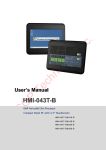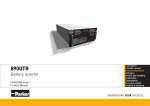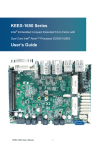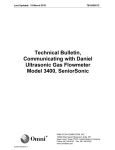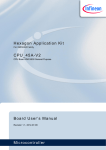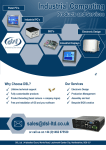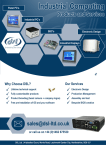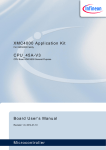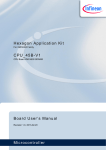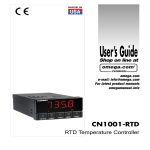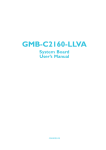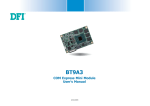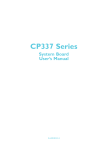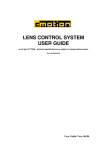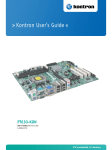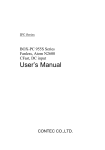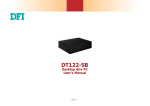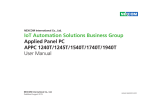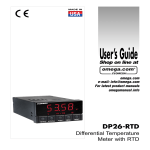Download Fanless Embedded System User`s Manual
Transcript
EC800 Fanless Embedded System User’s Manual A26060514 1 Chapter 1 Introduction www.dfi.com Copyright FCC and DOC Statement on Class A This publication contains information that is protected by copyright. No part of it may be reproduced in any form or by any means or used to make any transformation/adaptation without the prior written permission from the copyright holders. This equipment has been tested and found to comply with the limits for a Class A digital device, pursuant to Part 15 of the FCC rules. These limits are designed to provide reasonable protection against harmful interference when the equipment is operated in a residential installation. This equipment generates, uses and can radiate radio frequency energy and, if not installed and used in accordance with the instruction manual, may cause harmful interference to radio communications. However, there is no guarantee that interference will not occur in a particular installation. If this equipment does cause harmful interference to radio or television reception, which can be determined by turning the equipment off and on, the user is encouraged to try to correct the interference by one or more of the following measures: This publication is provided for informational purposes only. The manufacturer makes no representations or warranties with respect to the contents or use of this manual and specifically disclaims any express or implied warranties of merchantability or fitness for any particular purpose. The user will assume the entire risk of the use or the results of the use of this document. Further, the manufacturer reserves the right to revise this publication and make changes to its contents at any time, without obligation to notify any person or entity of such revisions or changes. • • • © 2015. All Rights Reserved. • Reorient or relocate the receiving antenna. Increase the separation between the equipment and the receiver. Connect the equipment into an outlet on a circuit different from that to which the receiver is connected. Consult the dealer or an experienced radio TV technician for help. Trademarks Notice: Product names or trademarks appearing in this manual are for identification purpose only and are the properties of the respective owners. 1. 2. The changes or modifications not expressly approved by the party responsible for compliance could void the user’s authority to operate the equipment. Shielded interface cables must be used in order to comply with the emission limits. 2 Chapter 1 Introduction www.dfi.com Table of Contents Copyright Trademarks About this Manual .............................................................................. 17 USB Ports ................................................................................................. 17 COM1 (Serial) Port .................................................................................... 18 CFast Socket ............................................................................................. 19 Mic-in jack ................................................................................................ 19 RJ45 LAN Ports ......................................................................................... 20 Rear Panel I/O Ports ............................................................................... 21 DVI-I Port ................................................................................................. 21 VGA Port ................................................................................................... 22 micro HDMI Port ....................................................................................... 22 DC-in ........................................................................................................ 23 Line-out jack ............................................................................................. 23 COM2 (Serial) Port/ Isolated 4-bit DIO ....................................................... 24 I/O Connectors .......................................................................................... 25 Digital I/O Connector ................................................................................. 25 Expansion Slots ......................................................................................... 25 Chassis Intrusion Connector ....................................................................... 26 Cooling Fan Connector ............................................................................... 26 LEDs ......................................................................................................... 27 Battery ..................................................................................................... 27 ................................................... 2 ......................................................................................... 4 ............................................................................................................ 4 Static Electricity Precautions Safety Measures .................................................................... 4 ............................................................................................ 4 Safety Precautions ........................................................................................ 5 About the Package ....................................................................................... 5 Chapter 1 - Introduction ........................................................................... 6 Overview ....................................................................................................... 6 Key Features ................................................................................................ 6 Specifications ............................................................................................... 7 Getting the Know the EC800 Series ..................................................... 8 Mechanical Dimensions ............................................................................. 9 Chapter 2 - Getting Started Chapter 6 - Mounting Options ................................................................... 10 Chapter 7 - BIOS Setup ........................................................................... 30 Overview ..................................................................................................... 30 AMI BIOS Setup Utility ........................................................................... 31 Updating the BIOS ................................................................................... 41 .............................................................. 11 Chapter 8 - Supported Software Removing the Chassis Cover ................................................................. 11 Installing a CFast Card ........................................................................... 12 Installing a SIM Card .............................................................................. 12 Installing a Mini PCIe and/or mSATA Card ....................................... 13 ......................................................... 42 Appendix A - Watchdog Sample Code Appendix B - System Error Message Installing the Mini PCIe Card ...................................................................... 13 Installing mSATA Card ............................................................................... 14 Chapter 4 - Jumper Settings .............................................................. 28 Wall Mount ................................................................................................. 28 VESA Mount ............................................................................................... 29 Preparing the System .............................................................................. 10 Installing Devices ..................................................................................... 10 Configuring the BIOS .............................................................................. 10 Installing the Operating System .......................................................... 10 Installing the Drivers ............................................................................... 10 Chapter 3 - Installing Devices ...................................................... 17 Front Panel I/O Ports ....................................................................................................... 2 FCC and DOC Statement on Class A Warranty Chapter 5 - Ports and Connectors ........................................................................................................... 2 .............................................. 56 ................................................. 57 Appendix C - Troubleshooting Checklist Appendix D - Exploded Diagram ................................................................. 15 ......................................................... 60 Appendix E - Digital I/O User Guide Power-on/ Clear CMOS ........................................................................... 15 USB Power Select ..................................................................................... 16 COM2/ DIO Select .................................................................................... 16 ........................................... 58 ................................................. 61 3 Chapter 1 Introduction www.dfi.com About this Manual Static Electricity Precautions An electronic file of this manual is included in the CD. To view the user’s manual in the CD, insert the CD into a CD-ROM drive. The autorun screen (Main Board Utility CD) will appear. Click “User’s Manual” on the main menu. It is quite easy to inadvertently damage your PC, system board, components or devices even before installing them in your system unit. Static electrical discharge can damage computer components without causing any signs of physical damage. You must take extra care in handling them to ensure against electrostatic build-up. 1. To prevent electrostatic build-up, leave the system board in its anti-static bag until you are ready to install it. Warranty 1. 2. The warranty is void if the product has been subjected to physical abuse, improper installation, modification, accidents or unauthorized repair of the product. 3. Unless otherwise instructed in this user’s manual, the user may not, under any circumstances, attempt to perform service, adjustments or repairs on the product, whether in or out of warranty. It must be returned to the purchase point, factory or authorized service agency for all such work. 4. 2. Wear an antistatic wrist strap. Warranty does not cover damages or failures that arised from misuse of the product, inability to use the product, unauthorized replacement or alteration of components and product specifications. 3. Do all preparation work on a static-free surface. 4. Hold the device only by its edges. Be careful not to touch any of the components, contacts or connections. 5. Avoid touching the pins or contacts on all modules and connectors. Hold modules or con nectors by their ends. Important: Electrostatic discharge (ESD) can damage your processor, disk drive and other components. Perform the upgrade instruction procedures described at an ESD workstation only. If such a station is not available, you can provide some ESD protection by wearing an antistatic wrist strap and attaching it to a metal part of the system chassis. If a wrist strap is unavailable, establish and maintain contact with the system chassis throughout any procedures requiring ESD protection. We will not be liable for any indirect, special, incidental or consequencial damages to the product that has been modified or altered. Safety Measures To avoid damage to the system: • Use the correct AC input voltage range. To reduce the risk of electric shock: • Unplug the power cord before removing the system chassis cover for installation or servicing. After installation or servicing, cover the system chassis before plugging the power cord. Battery: • Danger of explosion if battery incorrectly replaced. • Replace only with the same or equivalent type recommend by the manufacturer. • Dispose of used batteries according to local ordinance. 4 Chapter 1 Introduction www.dfi.com Safety Precautions About the Package • Use the correct DC input voltage range. The package contains the following items. If any of these items are missing or damaged, please contact your dealer or sales representative for assistance. • Unplug the power cord before removing the system chassis cover for installation or servicing. After installation or servicing, cover the system chassis before plugging the power cord. • • • • 1 EC800 system unit 1 Power adapter: 60W 6 Mounting screws for Mini PCIe module 1 DVD disk includes - Manual - Drivers • 1 Quick Installation Guide • Danger of explosion if battery incorrectly replaced. • Replace only with the same or equivalent type recommend by the manufacturer. • Dispose of used batteries according to local ordinance. • Keep this system away from humidity. Optional Items • Place the system on a stable surface. Dropping it or letting it fall may cause damage. • • • • • The openings on the system are for air ventilation to protect the system from overheating. DO NOT COVER THE OPENINGS. • Place the power cord in such a way that it will not be stepped on. Do not place anything on top of the power cord. Use a power cord that has been approved for use with the system and that it matches the voltage and current marked on the system’s electrical range label. Wall Mount VESA Mount DIN Rail Mount Power Cord The board and accessories in the package may not come similar to the information listed above. This may differ in accordance to the sales region or models in which it was sold. For more information about the standard package in your region, please contact your dealer or sales representative. • If the system will not be used for a long time, disconnect it from the power source to avoid damage by transient overvoltage. Before Using the System • If one of the following occurs, consult a service personnel: Before powering-on the system, prepare the basic system components. - The power cord or plug is damaged. - Liquid has penetrated the system. If you are installing the system board in a new system, you will need at least the following internal components. - The system has been exposed to moisture. • Storage devices such as CFast card, Mini PCIe and/or mSATA card, etc. - The system is not working properly. You will also need external system peripherals you intend to use which will normally include at least a keyboard, a mouse and a video display monitor. - The system dropped or is damaged. - The system has obvious signs of breakage. • The unit uses a three-wire ground cable which is equipped with a third pin to ground the unit and prevent electric shock. Do not defeat the purpose of this pin. If your outlet does not support this kind of plug, contact your electrician to replace the outlet. • Disconnect the system from the DC outlet before cleaning. Use a damp cloth. Do not use liquid or spray detergents for cleaning. 5 Chapter 1 Introduction www.dfi.com Chapter 1 Chapter 1 - Introduction Overview Key Features EC800 Series Processor Intel® AtomTM D2550/N2800/N2600 processors Chipset Intel® NM10 LAN 2 LAN ports COM 2 COM ports Display DVI-I; or VGA and micro HDMI USB 4 Type A USB 2.0/1.1 ports at the front panel Audio Mic-in and Line-out DIO 1 DB-9 port with DVI-I with VGA and micro HDMI 6 Chapter 1 Introduction www.dfi.com Chapter 1 Specifications Processor System • CPU: - Intel® AtomTM D2550, 1.86GHz, 2x 512K L2, 10W TDP, dual-core - Intel® AtomTM N2800, 1.86GHz, 2x 512K L2, 6.5W TDP, dual-core - Intel® AtomTM N2600, 1.60GHz, 2x 512K L2, 3.5W TDP, dual-core • Chipset: - Intel® NM10 Express Chipset Memory • 2GB DDR3 onboard (default) - Intel® AtomTM D2550/N2800 supports up to 4GB* (optional) Graphics • • • • • • Intel® GMA 3650 (Intel® AtomTM D2550/N2800) Intel® GMA 3600 (Intel® AtomTM N2600) 1 DVI-I port supports display resolution up to 1920x1200 1 VGA port supports display resolution up to 1920x1200 1 micro HDMI port supports display resolution up to 1920x1080 Smooth Video Playback - Supports hardware decoders (H.264, VC-1, MPEG-4) with Full HD 1080p video playback capability Front I/O Ports • • • • • • • • • Construction • Aluminum Mounting • Wall/VESA/DIN Rail mount - Mounting brackets and screws* (optional) Dimensions • 161mm x 32mm x 108.2mm (W x H x D) Weight • 700g • Windows XP, WES 2009, POSReady 2009, Windows 7, WES 7 • Linux (Distribution available upon request) 1 1 2 4 1 1 1 1 1 DB-9 RS232/422/485 COM mic-in LAN USB 2.0 (Type A) CFast socket status LED HDD LED reset button power button with LED Storage • 1 CFast socket • 1 mSATA module via a Mini PCIe slot OS Support Ethernet • 2 Intel® WG82574L Gigabit Ethernet controllers Other Features • Watchdog Timer function Audio • Realtek ALC886 7.1-channel High Definition Audio • 1 line-out and 1 mic-in Certification COM • 2 DB-9 ports - 1 DB-9 port supports RS232/422/485 COM port - 1 DB-9 port supports RS232/422/485 COM or isolated 2-bit In and 2-bit Out DIO • Supports RS485 auto direction control • • • • • • Expansion • 3 Mini PCIe slots - 2 slots for communication : One slot supports PCIe x1, USB, and LPC signals for Wi-Fi module or LPC module : One slot supports PCIe x1, USB, and 3G signals for 3G or GPRS module - 1 slot for storage : Supports mSATA module • 1 SIM card socket • 1 CFast ® CE FCC Class A RoHS UL CCC KC Rear I/O Ports EC800-CD2040 EC800-CD1440 EC800-CD2041 DC-in power jack 1 1 1 Wi-Fi/3G module antenna hole 2 2 2 Line-out 1 1 1 DVI 1 1 0 DIO • 1 isolated 4-bit DIO via the DB-9 port (signal+power)* (optional) VGA:DB-15 D-sub 0 0 1 Power • 9~24V DC power input voltage micro HDMI 0 0 1 Environment • Temperature - Operating: 0oC ~ 60oC - Storage: -40oC ~ 80oC • Humidity - Operating: 10% to 85% non-condensing - Storage: 10% to 90% non-condensing COM: DB-9 2 1 2 DIO: DB-9 (signal+power) 0 1 0 Note: *Optional and is not supported in standard model. Please contact your sales representative for more information. 7 Chapter 1 Introduction www.dfi.com Chapter 1 Getting to Know the EC800 Series Front View Rear View HDD LED Mic-in Wi-Fi/3G Antenna Reset LAN 2 LAN 1 USB Power with DVI-I 9~24V DC-in COM CFast Wi-Fi/3G Antenna DVI-I Line-out COM Status LED Wi-Fi/3G Antenna USB Ports Used to connect USB 2.0/1.1 devices. Wi-Fi/3G Antenna with VGA and micro HDMI LAN Ports Used to connect systems to a local area network. Mic-in Used to connect an external microphone. 9~24V DC-in COM Port Used to connect serial devices. VGA Line-out micro HDMI COM 2 Wi-Fi/3G Antenna Hole Used to connect to a Wi-Fi antenna. CFast Socket Used to insert a CFast card. DVI-I Port Used to connect a DVI device. Status LED This LED will blink when the system is in the standby mode. VGA Port Used to connect a VGA device. HDD LED Indicates the status of the hard drive. micro HDMI Port Used to connect a micro HDMI device. Power Button with LED Press to power-on or power-off the system. COM Port Used to connect serial devices. Reset Button Press to reset the system. Line-out Used to connect to a speaker. DC-in jack Used to plug a power adapter. 8 Chapter 1 Introduction www.dfi.com Chapter 1 Mechanical Dimensions Chassis Dimension Motherboard Dimension 132.80 85.16 60.90 48.89 27.72 161.00 102.00 98.40 108.20 79.32 60.54 58.47 44.21 37.32 Right View 32.00 Left View 3.20 0.00 Front View 146.00 142.90 134.80 126.04 117.27 93.35 108.77 101.53 100.27 79.00 62.50 48.89 43.53 27.76 8.90 0.00 9 Chapter 1 Introduction www.dfi.com Chapter 2 Chapter 2 - Getting Started Preparing the System Before you start using the system, you need the following items: • • • • • CFast card AC power adapter USB keyboard USB mouse CD-ROM drive (for installing software/drivers) Installing Devices The following are devices that can be installed in the system. • • CFast card Mini PCIe card Configuring the BIOS To get you started, you may need to change configurations such as the date, time and the type of hard disk drive. 1. 2. Power-on the system. After the memory test, the message “Press DEL to run setup” will appear on the screen. Press the Delete key to enter the AMI BIOS setup utility. Installing the Operating System Most operating system software are provided in a CD therefore you need to install a CD-ROM drive in order to use the CD. Make sure a 2.5” SATA drive is already installed. 1. 2. Refer to the following chapters for information on connecting a CD-ROM drive and installing a SATA drive. Refer to your operating system manual for instructions on installing the operating system. Installing the Drivers The system package includes a CD disk. The CD includes drivers that must be installed to provide the best system performance. Refer to the Supported Software chapter for instructions on installing the drivers. 10 Chapter 2 Getting Started www.dfi.com Chapter 3 Chapter 3 - Installing Devices 5. The CFast socket, and Mini PCIe/mSATA slot are readily accessible after removing the chassis cover. And the SIM slot is also accessible at the side of the system board. Removing the Chassis Cover 1. Make sure the system and all other peripheral devices connected to it has been powered-off. PCIe x1, USB, 3G signal 2. Disconnect all power cords and cables. 3. The 4 mounting screws on the bottom side (labeled side) of the system are used to secure the cover to the chassis. Remove these screws and then put them in a safe place for later use. mSATA CFast Socket Mounting Screw PCIe x1, USB, Wi-Fi signal SIM slot 4. After removing the mounting screws, lift the cover up. Lift the Cover Upward 11 Chapter 3 Installing Devices www.dfi.com Chapter 3 Installing a CFast Card Installing a SIM Card 1. Locate the CFast socket on the system board. 1. Locate the SIM slot on the system board. CFast Socket 2. Note the key on the socket. The key ensures the CFast card can be plugged into the socket in only one direction. SIM slot 2. Insert the SIM card in the SIM slot, and push the SIM card to take the card out of the slot. SIM card 3. Insert the CFast card until it is completely seated in the socket. CFast Socket CFast Card Note: Before powering-on the system, make sure to insert the CFast card. 12 Chapter 3 Installing Devices www.dfi.com Chapter 3 Installing a Mini PCIe and/or mSATA card 3. Grasping the Mini PCIe card by its edges, align the card into the slot at an approximately 30 degrees angle. Apply firm even pressure to each end of the card until it slips down into the slot. The contact fingers on the edge of the card will almost completely disappear inside the slot. PCIe x1, USB, and 3G signals Installing the Mini PCIe Card 1. Locate the Mini PCIe slot on the system board. PCIe x1, USB, and Wi-Fi signals PCIe x1, USB, 3G signal PCIe x1, USB, Wi-Fi signal 4. Push the Mini PCIe card down and use the provided mounting screws to secure the card on the system board. Mounting Screw 2. The system board is equipped with 2 Mini PCIe slots. The Mini PCIe slot supports full length and half length Mini PCIe card. Note the key on the slot. The key ensures the Mini PCIe card can be plugged into the slot in only one direction. Full length Half length 13 Chapter 3 Installing Devices www.dfi.com Chapter 3 Installing the mSATA Card 3. Grasping the mSATA card by its edges, align the card into the slot at an approximately 30 degrees angle. Apply firm even pressure to each end of the card until it slips down into the slot. The contact fingers on the edge of the card will almost completely disappear inside the slot. 1. Locate the mSATA slot on the system board. mSATA Card mSATA 4. Push the mSATA card down and use the provided mounting screws to secure the card on the system board. 2. The system board is equipped with a mSATA slot. The mSATA slot supports full length mSATA card. Note the key on the slot. The key ensures the mSATA card can be plugged into the slot in only one direction. Full length Mounting Screw 14 Chapter 3 Installing Devices www.dfi.com Chapter 4 Chapter 4 - Jumper Settings Power-on/ Clear CMOS JP5 1 2 3 4 5 6 2-4 On: Normal (default) 1 2 3 4 5 6 1-3 On: Power-on via power button (default) 1 3 5 1 3 5 2 4 6 3-5 On: Auto Power-on 2 4 6 4-6 On: Clear CMOS Power-on Clear CMOS JP5 is used to select the method of powering on the system. If you want the system to power-on whenever AC power comes in, set JP5 pins 3 and 5 to On. If you want to use the power button, set pins 1 and 3 to On. If you encounter the following, a) CMOS data becomes corrupted. b) You forgot the supervisor or user password. When using the JP5 “Power On” feature to power the system back on after a power failure occurs, the system may not power on if the power lost is resumed within 5 seconds (power flicker). you can reconfigure the system with the default values stored in the ROM BIOS. To load the default values stored in the ROM BIOS, please follow the steps below. 1. Power-off the system and unplug the power cord. Note: In order to ensure that power is resumed after a power failure that recovers within a 5 second period, JP5 must be set to pins 3-5 and the “AC Power Lose” in CMOS is set to “On”. 2. Set JP5 pins 4 and 6 to On. Wait for a few seconds and set JP5 back to its default setting, pins 2 and 4 On. 3. Now plug the power cord and power-on the system. 15 Chapter 4 Jumper Settings www.dfi.com Chapter 4 USB Power Select COM2/DIO Select 1 3 5 1-3 On: +5V 2 4 6 2 4 6 1 3 5 4-6 On: +5V_standby (default) 1 3 5 3-5 On: +5V_standby (default) 10 7 4 1 1-4-7-10, 2-5-8-11 On: COM2 (default) VGA / DVI-I 1 3 5 2-4 On: +5V JP9 and JP10 VGA VGA / DVI-I VGA USB 2-5 2 4 6 1 1 JP8 USB 0-1 2 4 6 12 9 6 3 12 9 6 3 10 7 4 1 2-5-8-11, 3-6-9-12 On: DIO These jumpers are used to select the power of the USB ports. Selecting +5V_standby will allow you to use a USB device to wake up the system. The system board uses JP9 and JP10 to select between RS232/422/485 COM2 or isolated 4-bit DIO at the rear panel. Note: You cannot use COM2 and DIO at the same time. Please set up JP9 and JP10 at the same time. Important: If you are using the Wake-On-USB Keyboard/Mouse function for 2 USB ports, the +5V_standby power source of your power supply must support ≥1.5A. For 3 or more USB ports, the +5V_standby power source of your power supply must support ≥2A. 16 Chapter 4 Jumper Settings www.dfi.com Chapter 5 Chapter 5 - Ports and Connectors USB Ports Front Panel I/O Ports COM LAN 1 USB 0-3 USB CFast • 4 USB ports • 1 CFast socket • 1 COM port • 2 LAN ports • 1 Mic-in jack 1 2 VGA VCC -Data +Data GND Key The front panel I/O port consists of the following: VCC -Data +Data GND N. C. 9 10 VGA / DVI-I Mic-in 1 LAN 2 USB 4-5 USB allows data exchange between your computer and a wide range of simultaneously accessible external Plug and Play peripherals. The system board is equipped with 4 USB 2.0/1.1 ports (USB 0-3). The 10-pin connector allow you to connect 2 additional USB 2.0/1.1 ports (USB 4-5). • BIOS Setting Configure the onboard USB in the Advanced menu (“USB Configuration” submenu) of the BIOS. Refer to chapter 7 for more information. • Driver Installation You may need to install the proper drivers in your operating system to use the USB device. Refer to your operating system’s manual or documentation for more information. 17 Chapter 5 Ports and Connectors www.dfi.com Chapter 5 COM1 (Serial) Port Wake-On-USB Keyboard/Mouse The Wake-On-USB Keyboard/Mouse function allows you to use a USB keyboard or USB mouse to wake up a system from the S3 (STR - Suspend To RAM) state. To use this function: • Jumper Setting 1 JP8 must be set to “4-6 On: +5V_standby”. Refer to “USB Power Select” in this chapter for more information. COM1: RS232/422/485 VGA VGA / DVI-I Important: If you are using the Wake-On-USB Keyboard/Mouse function for 2 USB ports, the +5V_standby power source of your power supply must support ≥1.5A. For 3 or more USB ports, the +5V_standby power source of your power supply must support ≥2A. The serial ports are asynchronous communication ports with 16C550A-compatible UARTs that can be used with modems, serial printers, remote display terminals, and other serial devices. • BIOS Setting Configure the serial ports in the Integrated Peripherals submenu (“Onboard I/O Chip Setup” section) of the BIOS. Refer to chapter 7 for more information. 67 8 9 RS232 RS422 Full Duplex DATA+ DATAN.C. N.C. GND 67 8 9 12345 67 8 9 N.C. N.C. N.C. N.C. RX+ RXTX+ TXGND 12345 N.C. N.C. N.C. N.C. 12345 DSR RTS CTS RI DCD RXD TXD DTR GND COM 1 RS485 18 Chapter 5 Ports and Connectors www.dfi.com Chapter 5 CFast Socket Mic-in jack 1 Mic-in VGA / DVI-I VGA CFast This jack is used to connect an external microphone. The CFast socket is used for inserting a CFast card. A CFast card is a small removable mass storage device designed with flash technology - a non-volatile storage solution that does not require a battery to retain data indefinitely. BIOS Setting Configure the onboard audio in the Chipset menu (“South Bridge” submenu) of the BIOS. Refer to chapter 3 for more information. Driver Installation Install the audio driver. Refer to chapter 8 for more information. 19 Chapter 5 Ports and Connectors www.dfi.com Chapter 5 RJ45 LAN Ports 1 LAN 1 VGA VGA / DVI-I LAN 2 Features • Intel® WG82574L PCI Express Gigabit Ethernet controller The LAN ports allow the system board to connect to a local area network by means of a network hub. BIOS Setting Configure the onboard LAN in the Chipset menu (“South Bridge Configuration” submenu) of the BIOS. Refer to chapter 7 for more information. Driver Installation Install the LAN drivers. Refer to chapter 8 for more information. 20 Chapter 5 Ports and Connectors www.dfi.com Chapter 5 Rear Panel I/O Ports DVI-I Port 1 9~24V DC-in DVI-I Line-out COM The rear panel I/O ports consist of the following: DVI port DC-in RS232/422/485 COM port or Isolated 4-bit DIO Line-out jack 9~24V DC-in VGA Line-out micro HDMI DVI-I COM 2 The DVI-I port is used to connect an LCD monitor. Connect the display device’s cable connector to the DVI-I port. After you plug the cable connector into the port, gently tighten the cable screws to hold the connector in place. The rear panel I/O ports consist of the following: • • • • • Rear I/O Ports 1 1 1 1 1 micro HDMI port VGA port DC-in RS232/422/485 COM port Line-out jack EC800CD2040-2x2 EC800CD1440-2x2 VGA / DVI-I 1 1 1 1 VGA • • • • BIOS Setting Configure the display device in the Chipset menu (“North Bridge Configuration” submenu) of the BIOS. Refer to chapter 7 for more information. EC800CDT2041-2x2 Driver Installation EC800CD2041-252 DC-in power jack 1 1 1 1 Wi-Fi/3G antenna hole 2 2 2 2 Line-out 1 1 1 1 DVI 1 1 0 0 VGA:DB-15 D-sub 0 0 1 1 micro HDMI 0 0 1 1 COM/DIO 2 1* 2 2 DIO: DB-9 (signal+power) 0 1* 0 0 Install the graphics driver. Refer to chapter 4 for more information. * Jumper selectable 21 Chapter 5 Ports and Connectors www.dfi.com Chapter 5 VGA Port micro HDMI Port 1 1 micro HDMI VGA VGA / DVI-I VGA / DVI-I VGA VGA The VGA port is used for connecting a VGA monitor. Connect the monitor’s 15-pin D-shell cable connector to the VGA port. After you plug the monitor’s cable connector into the VGA port, gently tighten the cable screws to hold the connector in place. The HDMI port which carries both digital audio and video signals is used to connect a LCD monitor or digital TV that has the HDMI port. BIOS Setting Configure VGA in the Chipset menu (“North Bridge Configuration” submenu) of the BIOS. Refer to chapter 3 for more information. Driver Installation Install the graphics driver. Refer to chapter 4 for more information. 22 Chapter 5 Ports and Connectors www.dfi.com Chapter 5 DC-in Line-out jack VGA / DVI-I VGA VGA This jack provides maximum of 60W power and is considered a low power solution. Connect a DC power cord to this jack. Use a power adapter within 9~24V DC output voltage. Using a voltage range out of 9~24V may fail to boot the system or cause damage to the system board. VGA / DVI-I 1 1 Line-out This jack is used to connect a headphone or external speakers. 23 Chapter 5 Ports and Connectors www.dfi.com Chapter 5 COM2 (Serial) Port/ Isolated 4-bit DIO RS232/422/485 COM2 or Isolated 4-bit DIO 1 Pins Isolated 4-bit DIO (2-bit in and 2-bit out) The isolated 4-bit Digital I/O connector provides powering-on function to external devices that are connected to these connectors. 67 8 9 RS422 Full Duplex 12345 67 8 9 N.C. N.C. N.C. N.C. RS232 DATA+ DATAN.C. N.C. GND RX+ RXTX+ TXGND 67 8 9 N.C. N.C. N.C. N.C. 12345 RS485 COM2 Function DIO Function RS232 RS422 RS485 1 DCD RX+ DATA+ DIN0A 2 RX RX- DATA- DIN0B 3 TX TX+ NC DIN1A 4 DTR TX- NC DIN1B 5 GND GND GND GND 6 DSR NC NC DOUT0A 7 RTS NC NC DOUT0B 8 CTS NC NC DOUT1A 9 RI NC NC DOUT1B COM2 (Serial) Port The serial port is an asynchronous communication ports with 16C550A-compatible UARTs that can be used with modems, serial printers, remote display terminals, and other serial devices. 12345 DSR RTS CTS RI VGA / DVI-I VGA This DB-9 port can be used as an RS232/422/485 COM port or as an isolated 4-bit DIO. Refer to the jumper setting in this section for its respective configuration. DCD RXD TXD DTR GND COM 2 24 Chapter 5 Ports and Connectors www.dfi.com Chapter 5 I/O Connectors Expansion Slots Mini PCIe slot for Mini PCIe slot for PCIe x1, USB, and Wi-Fi PCIe x1, USB, and 3G signals signals Mini PCIe for mSATA SIM slot Digital I/O Connector 1 1 1 20 19 VGA / DVI-I VGA 4-bit in and 4-bit out DIO with power VGA / DVI-I VGA 2 The 4-bit in and 4-bit out Digital I/O connector provides powering-on function to external devices that are connected to these connectors. Digital I/O Connector SIM Slot Pins Function Pins Function The SIM slot on the system board is used to insert a SIM card. 1 DIN0A 2 DOUT0A Mini PCI Express Slot 3 DIN0B 4 DOUT0B 5 DIN1A 6 DOUT1A The Mini PCI Express slot on the system board is used to install a half and/or full size Mini PCIe card such as network cards or other cards that comply to the mini PCI Express specifications into the mini PCI Express slot. 7 DIN1B 8 DOUT1B 9 DIN2A 10 DOUT2A 11 DIN2B 12 DOUT2B 13 DIN3A 14 DOUT3A 15 DIN3B 16 DOUT3B 17 +5V 18 +5V_standby 19 GND 20 GND 25 Chapter 5 Ports and Connectors www.dfi.com Chapter 5 Chassis Intrusion Connector Cooling Fan Connector 2 1 1 3 System fan VGA / DVI-I VGA VGA VGA / DVI-I 1 1 Ground Sense Power Ground Signal The board supports the chassis intrusion detection function. Connect the chassis intrusion sensor cable from the chassis to this connector. When the system’s power is on and a chassis intrusion occurred, an alarm will sound. When the system’s power is off and a chassis intrusion occurred, the alarm will sound only when the system restarts. The fan connectors are used to connect cooling fans. The cooling fans will provide adequate airflow throughout the chassis to prevent overheating the CPU and system board components. MyGuard Hardware Monitor The Advanced menu (“PC Health Configuration” submenu) of the BIOS will display the current speed of the cooling fans. Refer to chapter 7 for more information. BIOS Setting Install the “MyGuard Hardware Monitor” utility. By default, the chassis intrusion detection function is disabled. When enabled, a warning message will appear when the chassis is open. The utility can also be configured so that a beeping alarm will sound when the chassis is open. Refer to the “MyGuard Hardware Monitor” section in chapter 8 for more information. 26 Chapter 5 Ports and Connectors www.dfi.com Chapter 5 LEDs Battery Battery HDD LED Ground 1 1 Battery 1 VGA / DVI-I VGA / DVI-I VGA VGA Standby Power LED Standby Power LED This LED will blink when the system is in the standby mode. It indicates that there is power on the system board. Power-off the PC and then unplug the power cord prior to installing any devices. Failure to do so will cause severe damage to the motherboard and components. Battery Connect to the battery connector HDD LED The lithium ion battery powers the real-time clock and CMOS memory. It is an auxiliary source of power when the main power is shut off. The HDD LED will light when the hard drive is being accessed. Safety Measures • Danger of explosion if battery incorrectly replaced. • Replace only with the same or equivalent type recommend by the manufacturer. • Dispose of used batteries according to local ordinance. 27 Chapter 5 Ports and Connectors www.dfi.com Chapter 6 Chapter 6 - Mounting Options 2. At the bottom side of the system, use the provided mounting screws to secure the wallmount brackets on each side of the system. Wall Mount Mounting screw The wall mount kit includes the following: • • 2 Wall mount brackets Bracket screws Wall mount bracket Wall mount bracket 1. If the mounting screw has been previously attached at the bottom of the system, please remove them first. Mounting Screw 80.00 16.00 172.00 Ø8.50 Ø5.00 28 Chapter 6 Mounting Options www.dfi.com Chapter 6 VESA Mount The • • • 3. Align the VESA bracket A to the VESA bracket B and then use the provided mounting screws to secure the system in place. vesa mount kit includes the following: 1 VESA mount bracket A 2 VESA mount bracket B Bracket screws Mounting Screw EC800 VESA bracket A VESA bracket B 1. Prior to installing the VESA mount bracket A, make sure you have already installed the VESA mount bracket B. 46.00 2. Used the provided mounting screws to secure the VESA bracket A in place. 184.00 172.00 100.00 75.00 Mounting Screw 75.00 100.00 108.00 46.00 VESA bracket A Ø5.00 29 Chapter 6 Mounting Options www.dfi.com Chapter 6 DIN Rail Mount The • • • 2. Align the mounting holes of the system and the mounting holes on the bracket, and then use the screws removed on step 1 to secure the bracket in place. DIN Rail mount kit includes the following: 1 DIN Rail mount bracket 1 bracket Bracket screws EC800 Bracket EC800 1. Turn the system to the bottom side (labeled side) and top side and locate the mounting screw. Remove these screws and then put them in a safe place for later use. Bracket 3. The 3 mounting holes on the bracket of the system is used to mount the DIN rail bracket. Mounting Screw Top side Mounting Holes EC800 Bracket Mounting Screw Bottom side Mounting Holes 30 Chapter 6 Mounting Options www.dfi.com Chapter 6 4. Align the mounting holes of the bracket in the system and the mounting holes on the DIN rail bracket, and then use the provided mounting screws to secure the bracket in place. DIN Rail bracket Mounting Screw Bracket 31 Chapter 6 Mounting Options www.dfi.com Chapter 7 Chapter 7 - BIOS Setup Legends Overview Keys Function Right and Left arrows Moves the highlight left or right to select a menu. Up and Down arrows Moves the hightlight up or down between submenu or fields. <Esc> Exit to the BIOS Setup Utility. + (plus key) Scrolls forward through the values or options of the highlighted field. - (minus key) Scrolls backward through the values or options of the highlighted field. Tab Select a field. <F1> Displays General Help Default Configuration <F2> Previous Values Most of the configuration settings are either predefined according to the Load Optimal Defaults settings which are stored in the BIOS or are automatically detected and configured without requiring any actions. There are a few settings that you may need to change depending on your system configuration. <F3> Optimized Defaults <F4> Saves and exits the Setup program. <Enter> Press <Enter> to enter the highlighted submenu. The BIOS is a program that takes care of the basic level of communication between the CPU and peripherals. It contains codes for various advanced features found in this system board. The BIOS allows you to configure the system and save the configuration in a battery-backed CMOS so that the data retains even when the power is off. In general, the information stored in the CMOS RAM of the EEPROM will stay unchanged unless a configuration change has been made such as a hard drive replaced or a device added. It is possible that the CMOS battery will fail causing CMOS data loss. If this happens, you need to install a new CMOS battery and reconfigure the BIOS settings. Note: The BIOS is constantly updated to improve the performance of the system board; therefore the BIOS screens in this chapter may not appear the same as the actual one. These screens are for reference purpose only. Entering the BIOS Setup Utility Scroll Bar The BIOS Setup Utility can only be operated from the keyboard and all commands are keyboard commands. The commands are available at the right side of each setup screen. When a scroll bar appears to the right of the setup screen, it indicates that there are more available fields not shown on the screen. Use the up and down arrow keys to scroll through all the available fields. The BIOS Setup Utility does not require an operating system to run. After you power up the system, the BIOS message appears on the screen and the memory count begins. After the memory test, the message “Press DEL to run setup” will appear on the screen. If the message disappears before you respond, restart the system or press the “Reset” button. You may also restart the system by pressing the <Ctrl> <Alt> and <Del> keys simultaneously. Submenu When ““ appears on the left of a particular field, it indicates that a submenu which contains additional options are available for that field. To display the submenu, move the highlight to that field and press <Enter>. 32 Chapter 7 BIOS Setup www.dfi.com Chapter 7 AMI BIOS Setup Utility Advanced Main The Advanced menu allows you to configure your system for basic operation. Some entries are defaults required by the system board, while others, if enabled, will improve the performance of your system or let you set some features according to your preference. The Main menu is the first screen that you will see when you enter the BIOS Setup Utility. Main Important: Setting incorrect field values may cause the system to malfunction. Aptio Setup Utility - Copyright (C) 2012 American Megatrends, Inc. Advanced Chipset Save & Exit Boot Security BIOS Information BIOS Vendor Core Version Compliency Project Version Model Name Bios Name Bios Version Build Date and Time American Megatrends 4.6.5.1 UEFI 2.3; PI 1.2 1APJK 0.15.013 x64 DFI-CD952 CD9520C5.28A RA07 05/28/2012 23:08:56 System Date System Time [Mon 05/28/2012] [10:44:27] Access Level Administrator Set the date. Use Tab to switch between date elements Aptio Setup Utility - Copyright (C) 2012 American Megatrends, Inc. Main Advanced Chipset Legacy OpROM Support Launch PCI-E NIC PXE Launch I82574 WOL Launch Resume on Ring Launch Storage OpROM PCI Subsystem Settings ACPI Power Management CPU Configuration IDE Configuration USB Configuration Super IO Configuration PC Health Status JMB36X ATA Ctrl Config PPM Configuration WatchDog Configuration Select Screen Select Item Enter: Select +/-: Change Opt. F1: General Help F2: Previous Values F3: Optimized Defaults F4: Save & Exit ESC: Exit Boot Security Save & Exit [Disabled] [Disabled] [Disabled] [Enabled] Configuration Version 2.14.1219. Copyright (C) 2012 American Megatrends, Inc. System Date F81866A WDT Parameters. Select Screen Select Item Enter: Select +/-: Change Opt. F1: General Help F2: Previous Values F3: Optimized Defaults F4: Save & Exit ESC: Exit Version 2.14.1219. Copyright (C) 2012 American Megatrends, Inc. The date format is <day>, <month>, <date>, <year>. Day displays a day, from Sunday to Saturday. Month displays the month, from January to December. Date displays the date, from 1 to 31. Year displays the year, from 1980 to 2099. Legacy PCI-E NIC PXE Enable or Disable Boot option for Realtek 8111DL NIC. System Time Launch I82574 WOL The time format is <hour>, <minute>, <second>. The time is based on the 24-hour military-time clock. For example, 1 p.m. is 13:00:00. Hour displays hours from 00 to 23. Minute displays minutes from 00 to 59. Second displays seconds from 00 to 59. Enable or Disable WOL for Intel 82574 LAN Option. Launch Resume on Ring Enable or Disable resume on ring option. Launch Storage OpROM Enable or Disable Boot Option for Legancy Mass Storage Devices with Option ROM. 33 Chapter 7 BIOS Setup www.dfi.com Chapter 7 PCI Subsystem Settings ACPI Power Management Configuration This section is used to configure the PCI Subsystem. This section is used to configure the ACPI Setting. Aptio Setup Utility - Copyright (C) 2012 American Megatrends, Inc. Advanced Aptio Setup Utility - Copyright (C) 2012 American Megatrends, Inc. Advanced PCI Bus Driver Version PCI Option ROM Handling PCI ROM Priority V 2.05.01 [EFI Compatible ROM] ACPI Power Management Configuration Incase of multiple Option ROMs (Legancy and EFI compatible), specifies what PCI Option ROM to launch. Enables or disables BIOS ACPI Auto Configuration. Enable ACPI Auto Conf [Disabled] ACPI Sleep State Lock Legancy Resouces S3 Video Repost [S3 (Suspend to RAM) ] [Disabled] [Enabled] Resume by RTC Alarm USB Dev Wake from S3 [Disabled] [Disabled] Select Screen Select Item Enter: Select +/-: Change Opt. F1: General Help F2: Previous Values F3: Optimized Defaults F4: Save & Exit ESC: Exit Select Screen Select Item Enter: Select +/-: Change Opt. F1: General Help F2: Previous Values F3: Optimized Defaults F4: Save & Exit ESC: Exit Version 2.14.1219. Copyright (C) 2012 American Megatrends, Inc. Version 2.14.1219. Copyright (C) 2012 American Megatrends, Inc. Enable ACPI Auto Config Enables or disables BIOS ACPI Auto Configuration. ACPI Sleep State Selects the highest ACPI sleep state the system will enter when the Suspend button is pressed. S1(POS) Enables the Power On Suspend function. S3(STR) Enables the Suspend to RAM function. Lock Legacy Resources Enables or Disables Lock Legacy Resouces. Resume by RTC Alarm When Enabled, the system uses the RTC to generate a wakeup event. USB Dev Wake from S3 This field, when enabled, allows you to use a USB keyboard to wake up a system that is in the S3 (STR - Suspend To RAM) state. 34 Chapter 7 BIOS Setup www.dfi.com Chapter 7 CPU Configuration IDE Configuration This section is used to configure the CPU. It will also display the detected CPU information. This section is used to configure IDE functions. Aptio Setup Utility - Copyright (C) 2012 American Megatrends, Inc. Advanced Aptio Setup Utility - Copyright (C) 2012 American Megatrends, Inc. Advanced CPU Configuration Processor Type EMT64 Processor Speed System Bus Speed Ratio Status Actual Ratio Processor Stepping Microcode Revision L2 Cache RAM L3 Cache RAM Processor Core Huper-threading Intel (R) Atom (TM) CPU Supported 1865 MHz 533 MHz 14 14 30661 268 2x56 k 2x512 k Dual Supported Hyper-threading Execute Disable Bit Limit CUPID Maximum [Enabled] [Enabled] [Disabled] SATA Port0 SATA Port1 Enabled for Windows XP and Linux (OS optimized for Hyper-Threading Technology) and Disabled for other OS (OS not optimized for Hyper-Threading Technology). Not Present WDC WD800BEVS-(80.0G SATA Controller(s) [Enabled] Configure SATA as [IDE] SATA Ports (0-3) device names if present and enabled. Misc Configuration for hard disk Select Screen Select Item Enter: Select +/-: Change Opt. F1: General Help F2: Previous Values F3: Optimized Defaults F4: Save & Exit ESC: Exit Select Screen Select Item Enter: Select +/-: Change Opt. F1: General Help F2: Previous Values F3: Optimized Defaults F4: Save & Exit ESC: Exit Version 2.14.1219. Copyright (C) 2012 American Megatrends, Inc. Version 2.14.1219. Copyright (C) 2012 American Megatrends, Inc. Configure SATA as Hyper-threading Select a configuration for SATA controller. Enable this field for Windows XP and Linux which are optimized for Hyper-Threading technology. Select disabled for other OSes not optimized for Hyper-Threading technology. When disabled, only one thread per enabled core is enabled. Execute Disable Bit XD can prevent certain classes of malicious buffer overflow attacks when combined with a supporting OS (Windows Server 2003 SP1, Windows XP SP2, SuSE Linux 9.2, RedHat Enterprise 3 update 3.) Limit CUPID Maximum The CPUID instruction of some newer CPUs will return a value greater than 3. The default is Disabled because this problem does not exist in the Windows series operating systems. If you are using an operating system other than Windows, this problem may occur. To avoid this problem, enable this field to limit the return value to 3 or less than 3. 35 Chapter 7 BIOS Setup www.dfi.com Chapter 7 USB Configuration Super IO Configuration This section is used to configure USB. This section is used to configure the I/O functions supported by the onboard Super I/O chip. Aptio Setup Utility - Copyright (C) 2012 American Megatrends, Inc. Advanced USB Configuration USB Devices: 1 Keyboard, 1 mouse Legacy USB Support EHCI Hand-off [Enabled] [Enabled] Aptio Setup Utility - Copyright (C) 2012 American Megatrends, Inc. Advanced Enables Legacy USB support. AUTO option disables legacy support if no USB devices are connected. DISABLE option will keep USB devices available only for EFI applications. Set Parameters of Serial Port 1 (COMA). Super IO Configuration Super IO Chip Serial Serial F81866 Port 1 Configuration Port 2 Configuration Restore AC Power Loss Case Open Beep Select Screen Select Item Enter: Select +/-: Change Opt. F1: General Help F2: Previous Values F3: Optimized Defaults F4: Save & Exit ESC: Exit [Turns Off] [Disabled] Select Screen Select Item Enter: Select +/-: Change Opt. F1: General Help F2: Previous Values F3: Optimized Defaults F4: Save & Exit ESC: Exit Version 2.14.1219. Copyright (C) 2012 American Megatrends, Inc. Version 2.14.1219. Copyright (C) 2012 American Megatrends, Inc. Legacy USB Support Restore AC Power Lost Enabled Enables legacy USB. Off When power returns after an AC power failure, the system’s power is off. You must press the Power button to power-on the system. Auto Disables support for legacy when no USB devices are connected. On Disabled Keeps USB devices available only for EFI applications. When power returns after an AC power failure, the system will automatically power-on. EHCI Hand-off Last State This is a workaround for OSes that does not support EHCI hand-off. The EHCI ownership change should be claimed by the EHCI driver. When power returns after an AC power failure, the system will return to the state where you left off before power failure occurs. If the system’s power is off when AC power failure occurs, it will remain off when power returns. If the system’s power is on when AC power failure occurs, the system will power-on when power returns. Case Open Beep Set this field to Enabled to allow the system to alert you of a chassis intrusion event. 36 Chapter 7 BIOS Setup www.dfi.com Chapter 7 PC Health Status Serial Port 1 Configuration to Serial Port 2 Configuration This section displays the hardware health monitor. Aptio Setup Utility - Copyright (C) 2012 American Megatrends, Inc. Advanced Serial Port 1 Configuration Serial Port Device Settings [Enabled] IO=3F8h; IRQ=4; Change Settings [Auto] COM1 Driver Mode [RS232 driver] Aptio Setup Utility - Copyright (C) 2012 American Megatrends, Inc. Advanced Enable or Disable Serial Port (COM) Enable or Disable Smart Fan PC Health Status Select Screen Select Item Enter: Select +/-: Change Opt. F1: General Help F2: Previous Values F3: Optimized Defaults F4: Save & Exit ESC: Exit Smart Fan Function Smart Fan Mode Configuration CPU Temperature System Temperature System FAN Speed VCore VCCGFX V_SM 1.05V 5VSB 3VCC 3VSB VBAT [Enabled] : +34 C : +35 C : N/A : +1.064 V : +1.048 V : +1.568 V : +1.064 V : +4.992 V : +3.344 V : +3.360 V : +3.312 V Version 2.14.1219. Copyright (C) 2012 American Megatrends, Inc. Select Screen Select Item Enter: Select +/-: Change Opt. F1: General Help F2: Previous Values F3: Optimized Defaults F4: Save & Exit ESC: Exit Version 2.14.1219. Copyright (C) 2012 American Megatrends, Inc. Aptio Setup Utility - Copyright (C) 2012 American Megatrends, Inc. Advanced Serial Port 2 Configuration Serial Port Device Settings [Enabled] IO=2F8h; IRQ=3; Change Settings [Auto] COM2 Driver Mode [RS232 driver] Smart Fan Mode Configuration Enable or Disable Serial Port (COM) Aptio Setup Utility - Copyright (C) 2012 American Megatrends, Inc. Advanced Smart Fan Mode Select Smart Fan Mode Configuration System Fan Smart Fan Temperature 1 Temperature 2 Temperature 3 Temperature 4 Duty Cycle 1 Duty Cycle 2 Duty Cycle 3 Duty Cycle 4 Select Screen Select Item Enter: Select +/-: Change Opt. F1: General Help F2: Previous Values F3: Optimized Defaults F4: Save & Exit ESC: Exit [Auto Duty-Cycle Mode] 60 50 40 30 85 70 60 50 Select Screen Select Item Enter: Select +/-: Change Opt. F1: General Help F2: Previous Values F3: Optimized Defaults F4: Save & Exit ESC: Exit Version 2.14.1219. Copyright (C) 2012 American Megatrends, Inc. Serial Port Version 2.14.1219. Copyright (C) 2012 American Megatrends, Inc. Enables or disables the serial port. Change Settings Selects the IO/IRQ setting of the I/O device. COM1/2 Driver Mode Enable or disable serial port (COM) 37 Chapter 7 BIOS Setup www.dfi.com Chapter 7 PPM Configuration WatchDog Configuration This section is used to configure the PPM functions. This section is used to configure the watchdog functions. Aptio Setup Utility - Copyright (C) 2012 American Megatrends, Inc. Advanced Aptio Setup Utility - Copyright (C) 2012 American Megatrends, Inc. Advanced PPM Configuration EIST CPU C State Report [Disabled] [Disabled] Enable/Disable Intel SpeedStep Enable/Disable F81866 WatchDog Timer. WatchDog Configuration WatchDog function WatchDog Timer [Disabled] 10 Select Screen Select Item Enter: Select +/-: Change Opt. F1: General Help F2: Previous Values F3: Optimized Defaults F4: Save & Exit ESC: Exit Select Screen Select Item Enter: Select +/-: Change Opt. F1: General Help F2: Previous Values F3: Optimized Defaults F4: Save & Exit ESC: Exit Version 2.14.1219. Copyright (C) 2012 American Megatrends, Inc. Version 2.14.1219. Copyright (C) 2012 American Megatrends, Inc. CPU C State Report WatchDog function Enable/Disable CPU C Status Report to OS. This field is used to enable or disable the Watchdog timer function. 38 Chapter 7 BIOS Setup www.dfi.com Chapter 7 Chipset Host Bridge Configures relevant chipset functions. Main Aptio Setup Utility - Copyright (C) 2012 American Megatrends, Inc. Chipset Aptio Setup Utility - Copyright (C) 2012 American Megatrends, Inc. Advanced Chipset Boot Security Save & Exit Intel IGD Configuration IGFX - Boot Type Host Bridge Parameters Host Bridge South Bridge [VBIOS Default] Select the Video Device which will be activated during POST. This has no effect if external graphics present. Select Screen Select Item Enter: Select +/-: Change Opt. F1: General Help F2: Previous Values F3: Optimized Defaults F4: Save & Exit ESC: Exit Select Screen Select Item Enter: Select +/-: Change Opt. F1: General Help F2: Previous Values F3: Optimized Defaults F4: Save & Exit ESC: Exit Version 2.14.1219. Copyright (C) 2012 American Megatrends, Inc. IGFX - Boot Type Version 2.14.1219. Copyright (C) 2012 American Megatrends, Inc. Select the Video Device which will be activated during POST. This has no effect if external graphics present. 39 Chapter 7 BIOS Setup www.dfi.com Chapter 7 TPT Devices South Bridge Enable or disable Intel IO Controller Hub (TPT) devices. Aptio Setup Utility - Copyright (C) 2012 American Megatrends, Inc. Chipset TPT Devices PCI Express Root PCI Express Root PCI Express Root PCI Express Root Port Port Port Port 0 1 2 3 Aptio Setup Utility - Copyright (C) 2012 American Megatrends, Inc. Advanced Enable/ Disable Intel (R) IO Controller Hub (TPT) devices Azalia Controller [HD Audio] Select USB Mode UHCI #1 (ports 0 and 1) UHCI #2 (ports 2 and 3) UHCI #3 (ports 4 and 5) UHCI #4 (ports 6 and 7) USB 2.0 (EHCI) Support [By Controllers] [Enabled] [Enabled] [Enabled] [Enabled] [Enabled] Azalia Controller Select Screen Select Item Enter: Select +/-: Change Opt. F1: General Help F2: Previous Values F3: Optimized Defaults F4: Save & Exit ESC: Exit Select Screen Select Item Enter: Select +/-: Change Opt. F1: General Help F2: Previous Values F3: Optimized Defaults F4: Save & Exit ESC: Exit Version 2.14.1219. Copyright (C) 2012 American Megatrends, Inc. Version 2.14.1219. Copyright (C) 2012 American Megatrends, Inc. Select USB Mode This field is used to select the USB’s operation mode. High Speed If the USB device is a high speed device, it will operate in high speed mode. If it is a full/ low speed device, it will operate in full/low speed mode. Full/Low Speed Regardless of the speed of the USB device, it will always operate in full/low speed mode. UHCI 1~4 Control the USB UHCI (USB 1.1) function. USB 2.0 (EHCI) Support Enable or disable USB 2.0 (EHCI) support. 40 Chapter 7 BIOS Setup www.dfi.com Chapter 7 PCI Express Root Port 0~3 This section is used to configure the PCI Express Root functions. Aptio Setup Utility - Copyright (C) 2012 American Megatrends, Inc. Advanced PCI Express Port 0 [Enabled] Enable/Disable Intel SpeedStep Select Screen Select Item Enter: Select +/-: Change Opt. F1: General Help F2: Previous Values F3: Optimized Defaults F4: Save & Exit ESC: Exit Version 2.14.1219. Copyright (C) 2012 American Megatrends, Inc. PCI Express Port 0~3 Enable/Disable PCI Express Root Port 0~3. 41 Chapter 7 BIOS Setup www.dfi.com Chapter 7 Boot Security Aptio Setup Utility - Copyright (C) 2012 American Megatrends, Inc. Main Advanced Chipset Boot Security Boot Configuration Setup Prompt Timeout Bootup NumLock State 1 [On] Quiet Boot [Disabled] CSM16 Module Version 07.69 Option ROM Messages INT19 Trap Response [Force BIOS] [Postponed] Aptio Setup Utility - Copyright (C) 2012 American Megatrends, Inc. Save & Exit Driver Option Priorities Boot Option Priorities Main Number of seconds to wait for setup activation key. 65535(0xFFFF) means indefinite waiting. Advanced Chipset Boot Security Password Description If ONLY the Administrator’s password is set, then this only limits access to Setup and is only asked for when entering Setup. If ONLY the User’s password is set, then this is a power on password and must be entered to boot or enter Setup. In Setup the User will have Administrator rights. The password length must be in the following range: Minimum length 3 Maximum length 20 Select Screen Select Item Enter: Select +/-: Change Opt. F1: General Help F2: Previous Values F3: Optimized Defaults F4: Save & Exit ESC: Exit Administrator Password User Password HDD Security Configuration Save & Exit Set Administrator Password. Select Screen Select Item Enter: Select +/-: Change Opt. F1: General Help F2: Previous Values F3: Optimized Defaults F4: Save & Exit ESC: Exit Version 2.14.1219. Copyright (C) 2012 American Megatrends, Inc. Version 2.14.1219. Copyright (C) 2012 American Megatrends, Inc. Bootup NumLock State This allows you to determine the default state of the numeric keypad. By default, the system boots up with NumLock on wherein the function of the numeric keypad is the number keys. When set to Off, the function of the numeric keypad is the arrow keys. Administrator Password Quiet Boot User Password Enables or disables the quiet boot function. Sets the user password. Sets the administrator password. Option ROM Messages Set display mode for option ROM. INT19 Trap Response BIOS reaction on Int19 trapping by option ROM. Immediate Execute the trap right away. Postponed Execute the trap during legacy boot. Hard Driver BBS Priorities Set the order of the legacy devices in this group. 42 Chapter 7 BIOS Setup www.dfi.com Chapter 7 Save & Exit Updating the BIOS To update the BIOS, you will need the new BIOS file and a flash utility, AFUDOS.EXE. Please contact technical support or your sales representative for the files. Aptio Setup Utility - Copyright (C) 2012 American Megatrends, Inc. Main Advanced Chipset Boot Save Changes and Reset Discard Changes and Reset Security Save & Exit Reset the system after saving the changes. To execute the utility, type: A:> AFUDOS BIOS_File_Name /b /p /n then press <Enter>. Save Options Restore Defaults Save as User Defaults Restore User Defaults Boot Override C:\AFU\AFUDOS>afudos filename /B /P /N +--------------------------------------------------------------------------------------------------------+ | AMI Firmware Update Utility(APTIO) v2.25 | Copyright (C)2008 American Megatrends Inc. All Rights Reserved. +--------------------------------------------------------------------------------------------------------+ Select Screen Select Item Enter: Select +/-: Change Opt. F1: General Help F2: Previous Values F3: Optimized Defaults F4: Save & Exit ESC: Exit Reading file .............................. Erasing flash ............................. Writing flash ............................. Verifying flash .......................... Erasing BootBlock .................... Writing BootBlock .................... Verifying BootBlock ................. Version 2.14.1219. Copyright (C) 2012 American Megatrends, Inc. | | done done done done done done done C:\AFU\AFUDOS> Save Changes and Reset To save the changes, select this field and then press <Enter>. A dialog box will appear. Select Yes to reset the system after saving all changes made. Discard Changes and Reset After finishing BIOS update, please turn off the AC power. Wait about 10 seconds and then turn on the AC power again. To discard the changes, select this field and then press <Enter>. A dialog box will appear. Select Yes to reset the system setup without saving any changes. Restore Defaults To restore and load the optimized default values, select this field and then press <Enter>. A dialog box will appear. Select Yes to restore the default values of all the setup options. Save as User Defaults To save changes done so far as user default, select this field and then press <Enter>. A dialog box will appear. Select Yes to save values as user default. Restore User Defaults To restore user default to all the setup options, select this field and then press <Enter>. A dialog box will appear. Select Yes to restore user default. 43 Chapter 7 BIOS Setup www.dfi.com Chapter 8 Chapter 8 - Supported Software Auto Run Page (For Windows 7) The CD that came with the system board contains drivers, utilities and software applications required to enhance the performance of the system board. Insert the CD into a CD-ROM drive. The autorun screen (Mainboard Utility CD) will appear. If after inserting the CD, “Autorun” did not automatically start (which is, the Mainboard Utility CD screen did not appear), please go directly to the root directory of the CD and double-click “Setup”. Auto Run Page (For Windows XP) 44 Chapter 8 Supported Software www.dfi.com Chapter 8 Microsoft .NET Framework 3.5 (For Windows XP only) 3. Click Exit. Note: Before installing Microsoft .NET Framework 3.5, make sure you have updated your Windows XP operating system to Service Pack 3. To install the driver, click “Microsoft .NET Framework 3.5” on the main menu. 1. Read the license agreement carefully. Click “I have read and accept the terms of the License Agree ment” then click Install. 2. Setup is now installing the driver. 45 Chapter 8 Supported Software www.dfi.com Chapter 8 Microsoft DirectX 9.0C (For Windows XP only) Intel Chipset Software Installation Utility (For Windows XP) To install the utility, click “Microsoft DirectX 9.0C Driver” on the main menu. The Intel Chipset Software Installation Utility is used for updating Windows® INF files so that the Intel chipset can be recognized and configured properly in the system. 1. Click “I accept the agreement” then click Next. To install the utility, click “Intel Chipset Software Installation Utility” on the main menu. 1. Setup is now ready to install the utility. Click Next. 2. To start installation, click Next. 2. Read the license agreement then click Yes. 3. Click Finish. Reboot the system for DirectX to take effect. 46 Chapter 8 Supported Software www.dfi.com Chapter 8 Intel Chipset Software Installation Utility (For Windows 7) 3. Go through the readme document for system requirements and installation tips then click Next. The Intel Chipset Software Installation Utility is used for updating Windows® INF files so that the Intel chipset can be recognized and configured properly in the system. To install the utility, click “Intel Chipset Software Installation Utility” on the main menu. 1. Setup is now ready to install the utility. Click Next. 4. Setup is now installing the driver. Click Next to continue. 2. Read the license agreement then click Yes. 5. Click “Yes, I want to restart this computer now” then click Finish. Restarting the system will allow the new software installation to take effect. 47 Chapter 8 Supported Software www.dfi.com Chapter 8 Intel Graphics Drivers (For Windows XP) 3. Go through the readme document for system requirements and installation tips then click Next. To install the driver, click “Intel Graphics Drivers” on the main menu. 1. Setup is now ready to install the graphics driver. Select “Installs driver and application files“ and click Next. 2. Read the license agreement. Then, select “I agree“ and click Install. 4. After completing installation, click Finish to exit setup. 3. Click “Continue Anyway“ to start the installation. 48 Chapter 8 Supported Software www.dfi.com Chapter 8 Intel Graphics Drivers (For Windows 7) 4. Setup is now installing the driver. To install the driver, click “Intel Graphics Drivers” on the main menu. 1. Setup is now ready to install the graphics driver. Click Next. 5. Click “Yes” to restart this computer now. Restarting the system will allow the new software installation to take effect. By default, the “Automatically run WinSAT and enable the Windows Aero desktop theme” is enabled. With this enabled, after installing the graphics driver and the system rebooted, the screen will turn blank for 1 to 2 minutes (while WinSAT is running) before the Windows 7/ Windows 8 desktop appears. The “blank screen” period is the time Windows is testing the graphics performance. We recommend that you skip this process by disabling this function then click Next. 2. Read the license agreement then click Yes. 49 Chapter 8 Supported Software www.dfi.com Chapter 8 Audio Drivers (For Windows XP) 3. Go through the readme document for system requirements and installation tips then click Next. To install the driver, click “Audio Drivers” on the main menu. 1. Setup is now ready to install the audio driver. Click Next. 2. Follow the remainder of the steps on the screen; clicking “Next” each time you finish a step. 4. Setup is now installing the driver. Click Next to continue. 3. Click “Yes, I want to restart my computer now” then click Finish. Restarting the system will allow the new software installation to take effect. 5. Click “Yes, I want to restart this computer now” then click Finish. Restarting the system will allow the new software installation to take effect. 50 Chapter 8 Supported Software www.dfi.com Chapter 8 Audio Drivers (For Windows 7) Intel LAN Drivers (For Windows XP) To install the driver, click “Audio Drivers” on the main menu. To install the driver, click “Intel LAN Drivers” on the main menu. 1. Setup is ready to install the driver. Click Next. 1. Setup is now ready to install the driver. Click Next. 2. Follow the remainder of the steps on the screen; clicking “Next” each time you finish a step. 3. Click “Yes, I want to restart my computer now” then click Finish. 2. Click “I accept the terms in the license agreement” then click “Next”. Restarting the system will allow the new software installation to take effect. 3. Select the program featuers you want installed then click Next. 51 Chapter 8 Supported Software www.dfi.com Chapter 8 Intel LAN Drivers (For Windows 7) 4. Click Install to begin the installation. To install the driver, click “Intel LAN Drivers” on the main menu. 1. Setup is ready to install the driver. Click Next. 5. After completing installation, click Finish. 2. Click “I accept the terms in the license agreement” then click “Next”. 3. Select the program features you want installed then click Next. 52 Chapter 8 Supported Software www.dfi.com Chapter 8 Intel Rapid Storage Technology 4. Click Install to begin the installation. The Intel Rapid Storage Technology is a utility that allows you to monitor the current status of the SATA drives. It enables enhanced performance and power management for the storage subsystem. To install the driver, click “Intel Rapid Storage Technology” on the main menu. 1. Setup is now ready to install the utility. Click Next. 5. After completing installation, click Finish. 2. Read the warning then click Yes. 53 Chapter 8 Supported Software www.dfi.com Chapter 8 3. Read the license agreement then click Yes. 6. Click “Yes, I want to restart my computer now” then click Finish. Restarting the system will allow the new software installation to take effect. 4. Go through the readme document for system requirements and installation tips then click Next. 7. Run the Intel Matrix Storage Console utility to view the hard drives’ configuration. 5. Setup is now installing the utility. Click Next to continue. 54 Chapter 8 Supported Software www.dfi.com Chapter 8 F6 Floppy Configuration Utility DFI Utility This is used to create a floppy driver diskette needed when you install Windows XP using the F6 installation method. This will allow you to install the operating system onto a hard drive when in AHCI mode. DFI Utility provides information about the board, Watchdog, DIO, and Backlight. To access the utility, click “DFI Utility” on the main menu. ® Note: If you are using Windows 7, you need to access the operating system as an administrator to be able to install the utility. 1. Insert a blank floppy diskette. 2. Locate for the drivers in the CD then copy them to the floppy diskette. The CD includes drivers for both 32-bit and 64-bit operating systems. The path to the drivers are shown below. 1. Setup is ready to instal the DFI Utility driver Click “Next”. 32-bit CD Drive:\AHCI_RAID\F6FLOPPY\f6flpy32 64-bit CD Drive:\AHCI_RAID\F6FLOPPY\f6flpy64 2. Click “I accept the terms in the license agreement” then click “Next”. 55 Chapter 8 Supported Software www.dfi.com Chapter 8 3. Enter “User name” and “Organization” information then click “Next”. 4. Click “Install” to begin the installation. 5. After completing installa tion, click “Finish”. 56 Chapter 8 Supported Software www.dfi.com Chapter 8 Adobe Acrobat Reader 9.3 To install the reader, click “Adobe Acrobat Reader 9.3” on the main menu. 1. Click Next to install or click Change Destination Folder to select another folder. 2. Click Install to begin installation. 3. Click Finish to exit installation. 57 Chapter 8 Supported Software www.dfi.com Appendix A Appendix A - Watchdog Sample Code ;Software programming example: ;--------------------------------------------;(1) Enter Super IO Configuration mode ;--------------------------------------------MOV DX,2EH MOV AL,87H OUT DX,AL OUT DX,AL ;------------------------------------------------------------------------------------------;(2) Configuration Logical Device 7, register CRF5/CRF6 (WDT Control /WDT timer) ;------------------------------------------------------------------------------------------MOV DX,2EH MOV AL,07H ;Ready to Program Logical Device OUT DX,AL MOV MOV OUT DX,2FH AL,07H DX,AL ;Select Logical Device 7 MOV MOV OUT DX,2EH AL, F6H DX,AL ;Select watchdog timer register MOV MOV OUT DX,2FH AL,10H DX,AL ;Set watchdog timer value MOV MOV OUT DX,2EH AL, F5H DX,AL ;Select watchdog Control Register MOV MOV OUT DX,2FH AL,61H DX,AL ;Set Watchdog Control Value ;---------------------------------------------------------------;(1) Exit extended function mode ;---------------------------------------------------------------MOV DX,2EH MOV AL,AAH OUT DX,AL 58 Appendix A Watchdog Sample Code www.dfi.com Appendix B Appendix B - System Error Message Hard Disk(s) fail (20) When the BIOS encounters an error that requires the user to correct something, either a beep code will sound or a message will be displayed in a box in the middle of the screen and the message, PRESS F1 TO CONTINUE, CTRL-ALT-ESC or DEL TO ENTER SETUP, will be shown in the information box at the bottom. Enter Setup to correct the error. HDD initialization error. Error Messages Unable to recalibrate fixed disk. One or more of the following messages may be displayed if the BIOS detects an error during the POST. This list indicates the error messages for all Awards BIOSes: Hard Disk(s) fail (08) Hard Disk(s) fail (10) Sector Verify failed. CMOS BATTERY HAS FAILED Keyboard is locked out - Unlock the key The CMOS battery is no longer functional. It should be replaced. The BIOS detects that the keyboard is locked. Keyboard controller is pulled low. Keyboard error or no keyboard present Important: Danger of explosion if battery incorrectly replaced. Replace only with the same or equivalent type recommended by the manufacturer. Dispose of used batteries according to the battery manufacturer’s instructions. Cannot initialize the keyboard. Make sure the keyboard is attached being pressed during the boot. correctly and no keys are Manufacturing POST loop CMOS CHECKSUM ERROR System will repeat POST procedure infinitely while the keyboard controller is pull low. This is also used for the M/B burn in test at the factory. Checksum of CMOS is incorrect. This can indicate that CMOS has become corrupt. This error may have been caused by a weak battery. Check the battery and replace if necessary. BIOS ROM checksum error - System halted DISPLAY SWITCH IS SET INCORRECTLY The checksum of ROM address F0000H-FFFFFH is bad. The display switch on the motherboard can be set to either monochrome or color. This indicates the switch is set to a different setting than indicated in Setup. Determine which setting is correct, either turn off the system and change the jumper or enter Setup and change the VIDEO selection. Memory test fail The BIOS reports memory test fail if the memory has error(s). FLOPPY DISK(S) fail (80) Unable to reset floppy subsystem. FLOPPY DISK(S) fail (40) Floppy type mismatch. Hard Disk(s) fail (80) HDD reset failed. Hard Disk(s) fail (40) HDD controller diagnostics failed. 59 Appendix B System Error Message www.dfi.com Appendix C Appendix C - Troubleshooting Checklist The picture seems to be constantly moving. Troubleshooting Checklist 1. The monitor has lost its vertical sync. Adjust the monitor’s vertical sync. This chapter of the manual is designed to help you with problems that you may encounter with your personal computer. To efficiently troubleshoot your system, treat each problem individually. This is to ensure an accurate diagnosis of the problem in case a problem has multiple causes. 2. Move away any objects, such as another monitor or fan, that may be creating a magnetic field around the display. 3. Make sure your video card’s output frequencies are supported by this monitor. Some of the most common things to check when you encounter problems while using your system are listed below. The screen seems to be constantly wavering. 1. The power switch of each peripheral device is turned on. 1. If the monitor is close to another monitor, the adjacent monitor may need to be turned off. Fluorescent lights adjacent to the monitor may also cause screen wavering. 2. All cables and power cords are tightly connected. Power Supply 3. The electrical outlet to which your peripheral devices are connected is working. Test the outlet by plugging in a lamp or other electrical device. When the computer is turned on, nothing happens. 4. The monitor is turned on. 1. Check that one end of the AC power cord is plugged into a live outlet and the other end properly plugged into the back of the system. 5. The display’s brightness and contrast controls are adjusted properly. 2. Make sure that the voltage selection switch on the back panel is set for the correct type of voltage you are using. 6. All add-in boards in the expansion slots are seated securely. 3. The power cord may have a “short” or “open”. Inspect the cord and install a new one if necessary. 7. Any add-in board you have installed is designed for your system and is set up correctly. Monitor/Display Floppy Drive If the display screen remains dark after the system is turned on: The computer cannot access the floppy drive. 1. Make sure that the monitor’s power switch is on. 1. The floppy diskette may not be formatted. Format the diskette and try again. 2. Check that one end of the monitor’s power cord is properly attached to the monitor and the other end is plugged into a working AC outlet. If necessary, try another outlet. 2. The diskette may be write-protected. Use a diskette that is not write-protected. 3. Check that the video input cable is properly attached to the monitor and the system’s display adapter. 3. You may be writing to the wrong drive. Check the path statement to make sure you are writing to the targeted drive. 4. Adjust the brightness of the display by turning the monitor’s brightness control knob. 4. There is not enough space left on the diskette. Use another diskette with adequate storage space. 60 Appendix C Troubleshooting Checklist www.dfi.com Appendix C Hard Drive System Board Hard disk failure. 1. Make sure the add-in card is seated securely in the expansion slot. If the add-in card is loose, power off the system, re-install the card and power up the system. 1. Make sure the correct drive type for the hard disk drive has been entered in the BIOS. 2. Check the jumper settings to ensure that the jumpers are properly set. 2. If the system is configured with two hard drives, make sure the bootable (first) hard drive is configured as Master and the second hard drive is configured as Slave. The master hard drive must have an active/bootable partition. 3. Verify that all memory modules are seated securely into the memory sockets. 4. Make sure the memory modules are in the correct locations. Excessively long formatting period. 5. If the board fails to function, place the board on a flat surface and seat all socketed components. Gently press each component into the socket. If your hard drive takes an excessively long period of time to format, it is likely a cable connection problem. However, if your hard drive has a large capacity, it will take a longer time to format. 6. If you made changes to the BIOS settings, re-enter setup and load the BIOS defaults. Serial Port The serial device (modem, printer) doesn’t output anything or is outputting garbled characters. 1. Make sure that the serial device’s power is turned on and that the device is on-line. 2. Verify that the device is plugged into the correct serial port on the rear of the computer. 3. Verify that the attached serial device works by attaching it to a serial port that is working and configured correctly. If the serial device does not work, either the cable or the serial device has a problem. If the serial device works, the problem may be due to the onboard I/O or the address setting. 4. Make sure the COM settings and I/O address are configured correctly. Keyboard Nothing happens when a key on the keyboard was pressed. 1. Make sure the keyboard is properly connected. 2. Make sure there are no objects resting on the keyboard and that no keys are pressed during the booting process. 61 Appendix C Troubleshooting Checklist www.dfi.com Appendix D Appendix D - Exploded Diagram 531-510750-000G A31-027014-200G A33-630019-A70G A31-025011-200G A71-210010-000G A52-035008-000G PCBA-CD952 A33-530019-070G A31-027009-200G A31-023023-200G 62 Appendix D Exploded Diagram www.dfi.com Appendix E Appendix E - Digital I/O User Guide DIN Example with DIN0A/DIN0B CD952 Series: Isolated 8-bit Digital I/O Pin Define 1 IL max: 50mA For example: DIN= 5V RL= 500Ω IL= 1mA 2 1 VGA / DVI-I VGA 20 19 DFI DIO Utility D0 DIN1 H L L H 4-bit in and 4-bit out DIO with power The 4-bit in and 4-bit out Digital I/O connector provides powering-on function to external devices that are connected to these connectors. Set DIO at Input Mode Digital I/O Connector Example1 DIN1= 5V D0 to L. Pins Function Pins Function 1 DIN0A 2 DOUT0A 3 DIN0B 4 DOUT0B 5 DIN1A 6 DOUT1A 7 DIN1B 8 DOUT1B 9 DIN2A 10 DOUT2A 11 DIN2B 12 DOUT2B 13 DIN3A 14 DOUT3A 15 DIN3B 16 DOUT3B 17 +5V 18 +5V_standby 19 GND 20 GND 63 Appendix E Digital I/O User Guide www.dfi.com Appendix E DOUT Example1 with Dout0A/Dout0B Set DIO at Output Mode, Press D4 to H Example1 OUT1 to Low. Example2 OUT1 to High. VL: 60V max IL max: 600mA For example: VL= 5V RL= 1KΩ IL= 5mA DFI DIO Utility D4 OUT1 H L L H DOUT Example2 with Dout0A/Dout0B According DIO pin to GPIO Programming Setting DFI DIO Utility D4 OUT1 H L H L Pins Function 1 DIN0A 3 DIN0B 5 DIN1A 7 DIN1B 9 DIN2A 11 DIN2B 13 DIN3A 15 DIN3B 17 +5V 19 GND Couple for GPIO 80 Couple for GPIO 81 Couple for GPIO 82 Couple for GPIO 83 64 Appendix E Digital I/O User Guide www.dfi.com Appendix E DOUT MAP Pins Function 2 DOUT0A 4 DOUT0B 6 DOUT1A 8 DOUT1B 10 DOUT2A 12 DOUT2B 14 DOUT3A 16 DOUT3B 18 +5V_standby 20 GND Couple for GPIO 84 Couple for GPIO 85 Couple for GPIO 86 Couple for GPIO 87 DIN MAP 65 Appendix E Digital I/O User Guide www.dfi.com Appendix E Digital I/O Proramming Guide 3. Relative Registers 1. Pins for Digital I/O Item Standard GPIO80 (Pin111) GP80 GPIO81 (Pin112) GP81 GPIO82 (Pin113) GP82 GPIO83 (Pin114) GP83 GPIO84 (Pin115) GP84 GPIO85 (Pin116) GP85 GPIO86 (Pin117) GP86 GPIO87 (Pin118) GP87 GPIO71 (Pin104) CTR-GP71 GPIO72 (Pin105) CTR-GP72 2. Programming Guide To program the F81866A configuration registers, the following configuration procedures must be followed in sequence: (1) Enter the Extended Function Mode (2) Configure the configuration registers (3) Exit the Extended Function Mode The configuration register is used to control the behavior of the corresponding devices. To configure the register, using the index port to select the index and then writing data port to alter the parameters. The default index port and data port are 0x4E and 0x4F respectively. Pull down the SOUT1 pin to change the default value to 0x2E/0x2F. To enable configuration, the entry key 0x87 must be written to the index port. To disable configuration, write exit entry key 0xAA to the index port. Following is an example to enable configuration and disable configuration by using debug. -o 4e 87 -o 4e 87 (enable configuration) -o 4e aa (disable configuration) 66 Appendix E Digital I/O User Guide www.dfi.com Appendix E 67 Appendix E Digital I/O User Guide www.dfi.com Appendix E 4. Sample Code in C Language 4.2 Control of GP80 to GP87 4.1 Control of GP03, GP02 and GP07 #define AddrPort 0x2E #define DataPort 0x2F #define AddrPort 0x2E #define DataPort 0x2F <Enter the Extended Function Mode> WriteByte(AddrPort, 0x87) WriteByte(AddrPort, 0x87) //Must write twice to entering Extended mode <Enter the Extended Function Mode> WriteByte(AddrPort, 0x87) WriteByte(AddrPort, 0x87) //Must write twice to entering Extended mode <Select Logic Device> WriteByte(AddrPort, 0x07) WriteByte(DataPort, 0x06)// Select logic device 06h <Select Logic Device> WriteByte(AddrPort, 0x07) WriteByte(AddrPort, 0x06) //Select logic device 06h <Output/Input Mode Selection>//SetGP80 to GP87 I/O Mode WriteByte(AddrPort, 0x88)// Select configuration register 88h WriteByte(DataPort, (ReadByte(DataPort) & 0xXX)) //Set (bit n) = (1/0) to select GP 8n as Output/Input mode. <Get Input Value> WriteByte(AddrPort, 0x8A)// Select configuration register 8Ah Data = ReadByte(DataPort)// The “Data” represent the input value of GP80~87 <Output Mode Selection>//SetGPIO71/72 to output Mode WriteByte(AddrPort, 0x80)// Select configuration register 80h WriteByte(DataPort, (ReadByte(DataPort) ǀ 0x06)) //Set (bit 0/1) = (1) to select GPIO 71/72 as Output mode. <Output Value> WriteByte(AddrPort, 0x89)// Select configuration register 89h WriteByte(DataPort, Value)// Set bit n=(0/1) to output GP 8n as Low or High <Output Value> WriteByte(AddrPort, 0x81)// Select configuration register 81h WriteByte(DataPort, Value)// Set bit n=(1/2) to output GPI07n as Low or High <Leave the Extended Function Mode> WriteByte(AddrPort, 0xAA) <Leave the Extended Function Mode> WriteByte(AddrPort, 0xAA) 68 Appendix E Digital I/O User Guide www.dfi.com Appendix E CD952 Series: Isolated 4-bit Digital I/O Jumper Setting CD952 Series: Isolated 4-bit Digital I/O Pin Define COM2/DIO Select COM2 (Serial) Port/ Isolated 4-bit DIO 1 JP9/JP10 12 9 6 3 10 7 4 1 RS232/422/485 COM2 or Isolated 4-bit DIO 2 4 1 3 5 COM port mode 1 1-4-7-10, 2-5-8-11 On: COM2 (default) 7 9 6 8 VGA / DVI-I VGA 10 7 4 1 DIO mode 2-5-8-11, 3-6-9-12 On: DIO The system board uses JP9 and JP10 to select between RS232/422/485 COM2 or isolated 4-bit DIO at the rear panel. VGA / DVI-I VGA 12 9 6 3 Pins DIO Function 1 DIN0A 2 DIN0B 3 DIN1A 4 DIN1B 5 GND 6 DOUT0A 7 DOUT0B 8 DOUT1A 9 DOUT1B Note: You cannot use COM2 and DIO at the same time. Please set up JP9 and JP10 at the same time. 69 Appendix E Digital I/O User Guide www.dfi.com Appendix E Isolated 4-bit Digital I/O Input Request Pins Input Request *1 5V~12V 2 GND *3 5V~12V 4 GND GND 5 *6 7 *8 9 AC or DC Load Loading AC or DC 5V~60V AC or DC Load Loading AC or DC 5V~60V ABSOLUTE MAXIMUM RATINGS SPECIFICATION *Pin1/Pin3 : - Diode forward current(DC) rating IF =50mA/ch. *Pin6/Pin8 : - MOS FET Continuous Load Current rating IL =600mA. 70 Appendix E Digital I/O User Guide www.dfi.com Appendix E 4-bit (2-bit in and 2-bit out) description Pins Input Request *1 5V~12V 2 GND *3 5V~12V 4 GND 5 GND *6 7 *8 9 DOUT Example2 with Dout0A/Dout0B Pin 1 and 2 are couple, DIN1 Pin 3 and 4 are couple, DIN2 AC or DC Load Loading AC or DC 5V~60V Pin 6 and 7 are couple, OUT1 Loading AC or DC 5V~60V Pin 8 and 9 are couple, OUT2 DFI DIO Utility D4 OUT1 H L H L AC or DC Load Set DIO at Output Mode, Press D4 to H DOUT Example1 with Dout0A/Dout0B Example1 OUT1 to Low. Example2 OUT1 to High. VL: 60V max IL max: 600mA For example: VL= 5V RL= 1KΩ IL= 5mA DFI DIO Utility D4 OUT1 H L L H 71 Appendix E Digital I/O User Guide www.dfi.com Appendix E DOUT Example3 with Dout1A/Dout1B Set DIO at Output Mode, Press D5 to H Example3 OUT2 to Low. Example4 OUT2 to High. DFI DIO Utility D5 OUT2 H L L H DOUT Example4 with Dout1A/Dout1B DIN Example1 with DIN0A/DIN0B IL max: 50mA For example: DIN= 5V RL= 500Ω IL= 1mA DFI DIO Utility D5 OUT2 DFI DIO Utility D0 OUT1 H L H L H L L H 72 Appendix E Digital I/O User Guide www.dfi.com Appendix E Set DIO at Input Mode Set DIO at Input Mode Example1 DIN1= 5V D0 to L Example2 DIN2= 5V D1 to L DIN Example1 with DIN1A/DIN1B DFI DIO Utility D1 OUT2 H L L H 73 Appendix E Digital I/O User Guide www.dfi.com









































































